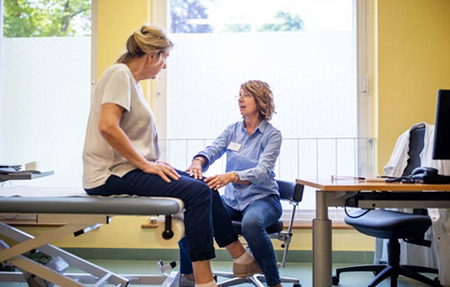What are painful muscle spasms and why do they occur?


Muscle spasms/cramps are sudden, short-lived, pain-causing contractions of one or several muscles. Seizures often occur in generally healthy individuals (most likely, in elderly individuals). They can occur at rest but are commonly related to physical exercise, or can occur during sleep.
The most frequent causes are:
Leg or foot cramps of a benign nature – they happen without any obvious reason, can occur during a workout or happen at night.
The most frequent type is the calf and foot cramps, they make the foot and toes bend. These are not dangerous or severe spasms so they are called benign.
Although almost anyone can have occasional muscle spasms, certain conditions/ circumstances elevate the risk:
- Tense calf muscles, if you don’t stretch them, if you are not very active, or in frequent the lower legs swelling;
- Dehydration;
- Electrolytes imbalance (e.g. low potassium, calcium etc.) in your blood;
- Nerve disorders;
- Insufficient production of thyroid hormones;
- Taking certain medications.
Decreased electrolytes can result from the use of some water pills, alcoholism, hormone disorders, or conditions that lead to fluid loss, for instance, poisoning and accompanying diarrhea and vomiting. Electrolytes are also usually low late in pregnancy.
Cramps may develop after dialysis, possibly due to excessive fluid removal during dialysis and/or a decrease in electrolyte levels.
Diseases causing cramps

- Dystonia is an unconscious muscle contraction that commonly has a longer duration and is more frequent than usual cramps. In addition, these disorders can involve many other muscles, for instance, in all limbs, spine, cervical, and vocal muscles, unlike leg cramps.
- Tetania is a repetitive or intermittent muscle spasm through the whole body. They are more intense and longer-lasting than normal cramps. Besides, muscle twitching may also happen.
- Some people have illusory muscle spasms. Such people have a sensation that resembles a spasm but without muscle contraction.
- The loss of elasticity of the walls of the arteries in the legs can cause pain in the calf muscle (intermittent claudication) even in walking. This pain can result from insufficient blood supply to the muscles, and not from the contraction.
How to find out the cause of cramps?
When assessing muscle spasms, the focus should be on trying to identify a treatable cause of the condition. Sometimes, people who have cramps are already diagnosed with disease that can cause them but doctors pay more attention to the other manifestations.
Anamnesis
The first step of determining the cause of cramps is the history of the disease. It should include a description of spasms, information about their duration, frequency of occurrence, localization, factors provoking their occurrence, and other manifestations of the potential disease.
Manifestations that may be caused by neurological or muscle disease include muscle rigidity, paresis, pain, and sensitivity impairment.
Dehydration that causes electrolyte disturbances can be determined if a patient suffers from diseases or conditions associated with vomiting, diarrhea, intense sweating. It can also be suspected in patients after recent dialysis, users of diuretics (water pills), and pregnant women.
Examination of body systems must imply looking for signs that indicate the cause of the condition:
- Menstrual disorders: calf cramps during pregnancy;
- Cold intolerance, excess weight, increased hairiness: hypothyroidism;
- Weakness: neurological disorders;
- Pain or sensitivity loss: neurological disorders.
Past medical conditions imply any disease that can induce muscle spasms. Details of previous therapy and alcohol use are collected.
Objective examination

Physical examination assesses the skin, including hairiness, and so on which may indicate low level of thyroid hormones. A neurological examination is done, including an assessment of tendon reflexes.
It is necessary to assess the pulse and measure blood pressure in all limbs. A weak pulse or a low ratio of blood pressure measured at the ankle in the affected leg to blood pressure measured at the shoulder may indicate the presence of ischemia.
The following symptoms are alarming:
- Involvement in the pathological process of the upper limbs or trunk;
- Overactive or overresponsive reflexes;
- Muscle weakness;
- Muscle twitching;
- Signs of alcoholism;
- Hypovolemia (decrease of vessels volume);
- Pain or decreased sensitivity in the area of innervation of a peripheral nerve;
Interpreting results
Localized seizures indicate benign idiopathic gastrocnemius cramps, exercise-induced muscle cramps, muscle or bone anomalies, nervous system diseases, or asymmetric degenerative diseases such as multiple sclerosis and others.
Localized decreased reflexes may indicate neuropathy, plexopathy, or radiculopathy.
In individuals with spread muscle cramps (especially in patients with tremors), an elevation in reflexes indicates a systemic cause (for instance, a decrease in the level of ionized calcium; in some cases - alcoholism, or medication). A diffuse decrease in reflexes can indicate hypothyroidism or, in some cases, occur with alcoholism, but it can also be observed in the norm, especially in the elderly.
Normal examination findings, coupled with an appropriate history, indicate benign idiopathic calf cramps or exertional muscle cramps.
Examination
- Testing is carried out in this way when violations are detected during a clinical examination. Testing is not routine.
- Blood sugar, renal function, and electrolytes must be measured first of all if an individual has diffuse seizures of unknown etiology, especially with hyperreflexia (overly active reflexes).
- Calcium ion content and arterial blood gas composition are measured.
- Electromyography is appointed when the tone of the patient's spasmodic muscles is weakened.
- In focal muscle weakness or focal neurological symptoms, an MRI scan of the brain and, often, the spinal cord is necessary.
Treatment

It is advised to do muscle stretching especially for people who live a sedentary lifestyle. Muscle relaxers such as Tizanidine can be also used to relieve the remaining spasm and pain after a seizure and prevent cramps during sleep.
When diagnosing the underlying disease, measures are taken to cure it.
When a spasm occurs, stretching often helps to relieve it. In leg cramps, the patient can straighten the foot and toes upward using the hands.
Prophylaxis of muscle cramps
- Do not do any physical exercises right after eating;
- Gently do muscle stretching before a workout or before bed;
- Drink enough water or other drinks (especially those containing potassium) after exercise;
- Do not use psychostimulants (e.g. caffeine, nicotine, and others);
- Do not smoke.
It is advised to receive all of the minerals and vitamins from the diet or use herbal and other natural supplements and use muscle-relaxers appointed by a doctor after a thorough examination.
Causes of muscle cramps
Drugs:
Adjunctive drugs: ARA, cisplatin, clofibrate, diuretics, donepezil, beta-adrenoceptor agonists (including bronchodilators and some beta-blockers), lovastatin, oral contraceptives, pyrazinamide, raloxifene, stimulants (eg, amphetamines, caffeine, cocaine, cocaine , pseudoephedrine), teriparatide, tolcapone, vincristine
Withdrawal of the following substances: alcohol, barbiturates, benzodiazepines, sedatives and sleeping pills
In some cases, excessive sweating, vomiting, diarrhea, use of diuretics, symptoms of dehydration.
Sometimes spasms develop during or after hemodialysis, or late in pregnancy (probably due to hypomagnesemia).Alcoholism: a history of alcohol abuse, sometimes ascites, gynecomastia, stellate hemangiomas, testicular atrophy.
Hypothyroidism: cold intolerance, constipation, fatigue, suppression of reflexes.
Alcoholism: Clinical evaluation.
Hypothyroidism: a study of thyroid function.
Peripheral neuropathies
Plexopathies
Radiculopathy
Motor neuron disease
Myopathies
Weakness, impaired sensation, pain and / or decreased reflexes in the area of innervation of the peripheral nerve, plexus or root.
Fasciculations (muscle twitching).
For motor neuron disease, weakness starting in one arm or leg.
Clinical evaluation.
In some cases - electromyography, study of the speed of propagation of excitation along the nerve and /or MRI of the spinal cord.
Compaction of the leg muscles, long-term sitting in anamnesis.
In patients with developmental abnormalities (eg, flat feet, knee recurvation).
Unprovoked muscle spasms, without a concomitant cause, usually in the calf muscles at night.
Usually - induration of the calf muscles.
Post by: John Avery, General Practitioner, Manchester, United Kingdom
(Updated at Apr 14 / 2024)
Zanaflex articles:
Some of the trademarks used in this Web Site appear for identification purposes only.
All orders are reviewed by a licensed physician and pharmacist before being dispensed and shipped.
The statements contained herein are not intended to diagnose, treat, cure or prevent disease. The statements are for informational purposes only and is it not meant to replace the services or recommendations of a physician or qualified health care practitioner. If you have questions about the drugs you are taking, check with your doctor, nurse, or pharmacist.